Grebes of all species very rarely try to walk or even come out of the water onto a solid surface. Because of their unusual anatomy standing and walking are almost impossible tasks but this one made the attempt anyway. The results were hilarious.
First a little background illustrated with a photo.
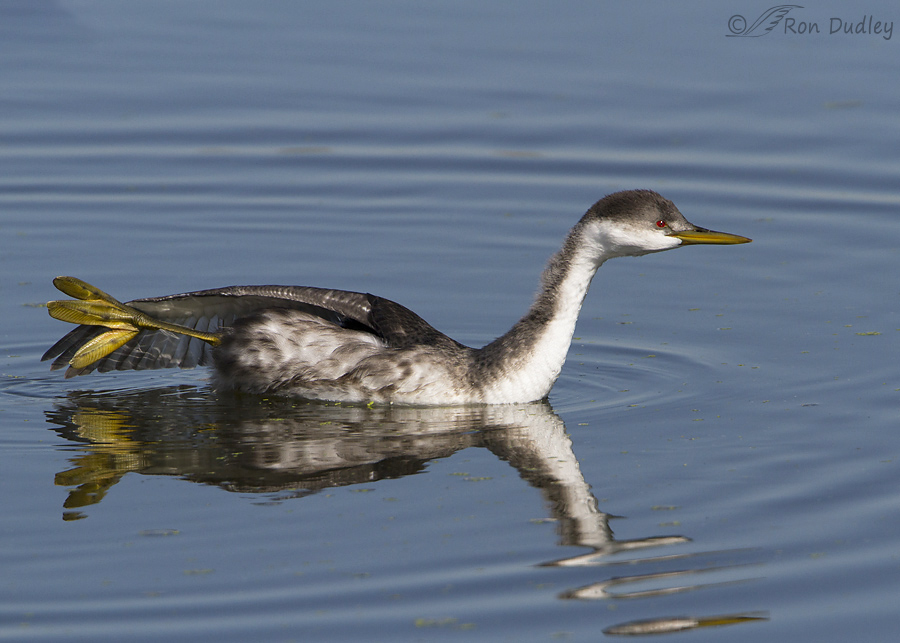
Yes, that’s actually a leg and foot sticking out of the rear end of this juvenile Western Grebe during a leg and wing stretch. Notice where the leg is attached to the body. In grebes the attachment is so far to the rear that walking is about like flying is for humans – we just don’t have the anatomy for it. On those very rare occasions when grebes do attempt to walk they have to try to stand with their bodies almost erect vertically which is extremely awkward and unnatural for them, to the point that the attempt is usually hilarious to watch.
Compare this leg placement to that of a walking duck and you’ll see what I mean. Duck legs are attached beneath them rather than at the rear. Over the years I’ve spent many hundreds of hours watching and photographing Western Grebes, often large numbers of them at the same time, and only on three occasions have I seen one come onto land and try to walk.
The sixteen photos below document one of those three attempts. They were taken several years ago at Bear River MBR. They’re only of documentary quality but I think they get the job done.
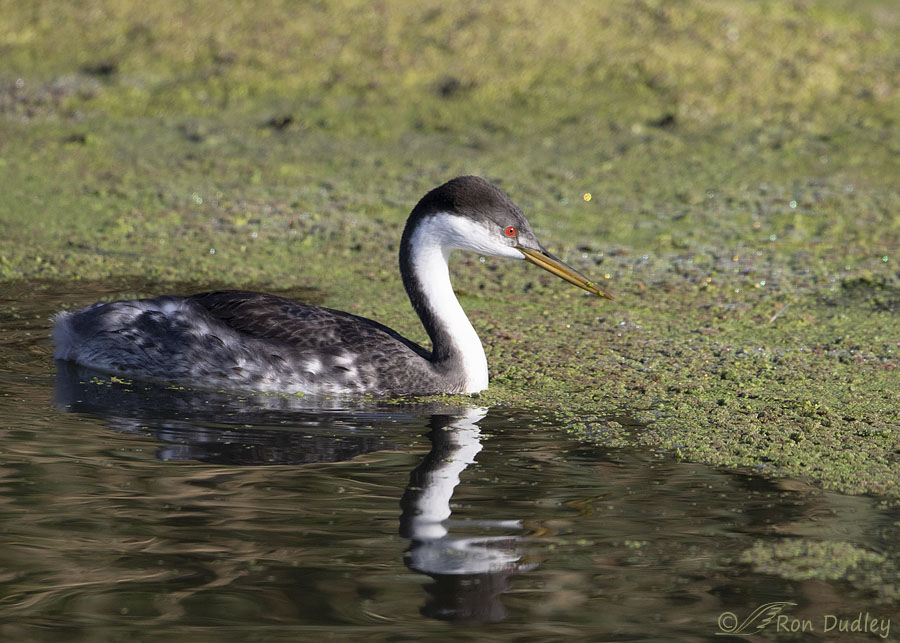
I didn’t know it at the time but apparently this grebe was eyeing a potential destination on the other side of the duckweed and on shore. Because of all the duckweed floating on the water and on top of the shore the actual shoreline is difficult to discern but it’s there somewhere under the duckweed that we see in this photo.
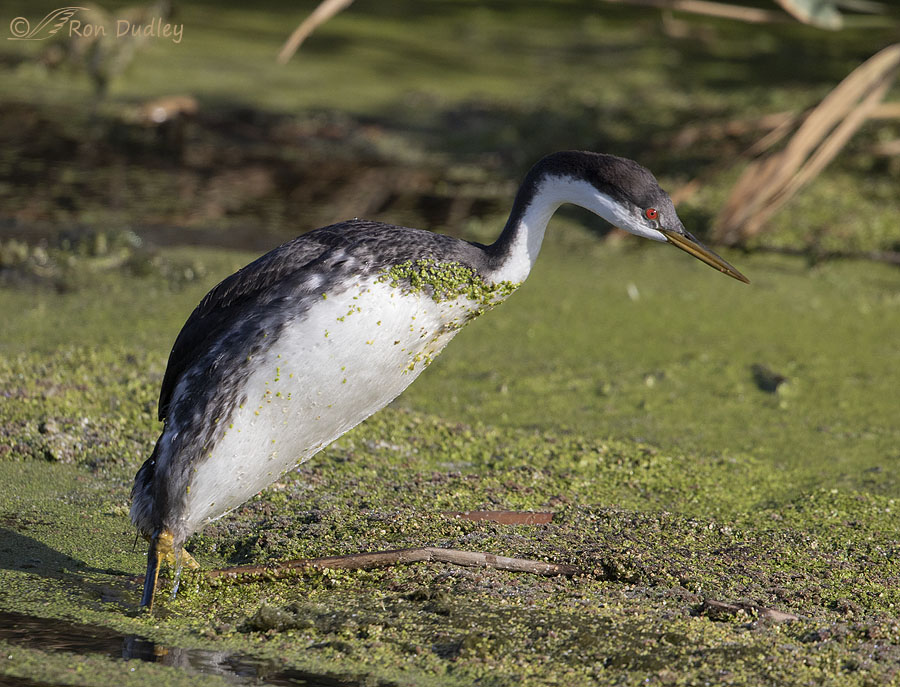
Suddenly “he” lifted out of the water and began to make the attempt to reach his destination somewhere on the shore. Here you can see that the water beneath his feet is only a few centimeters deep and the actual shoreline beneath the duckweed runs diagonally and is only about 2″ in front of his feet. There’s no water beneath the duckweed in front of him.
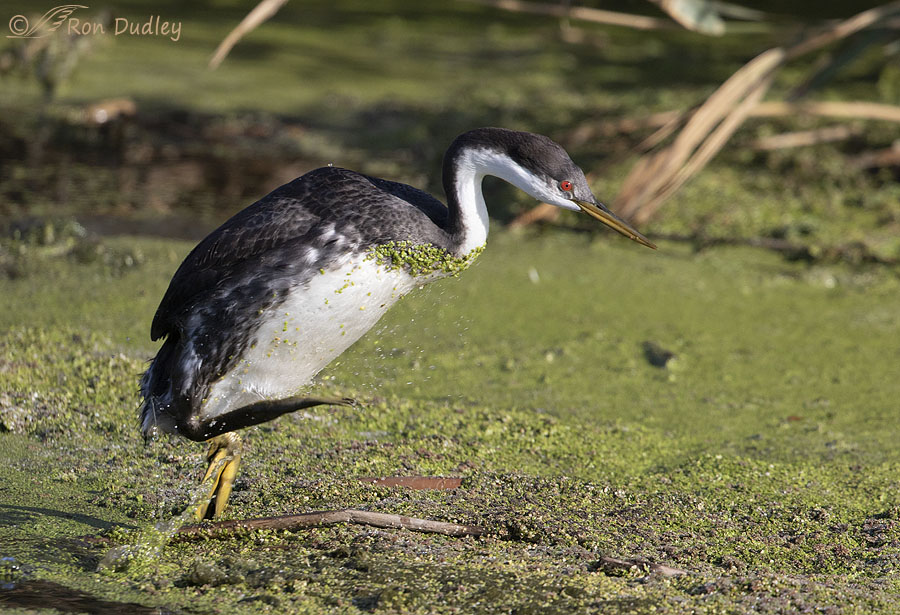
In this photo the tip of his left foot is right on the hidden shoreline. Now he’s actually beginning to walk (more like a slow run) on solid but wet ground beneath the duckweed.
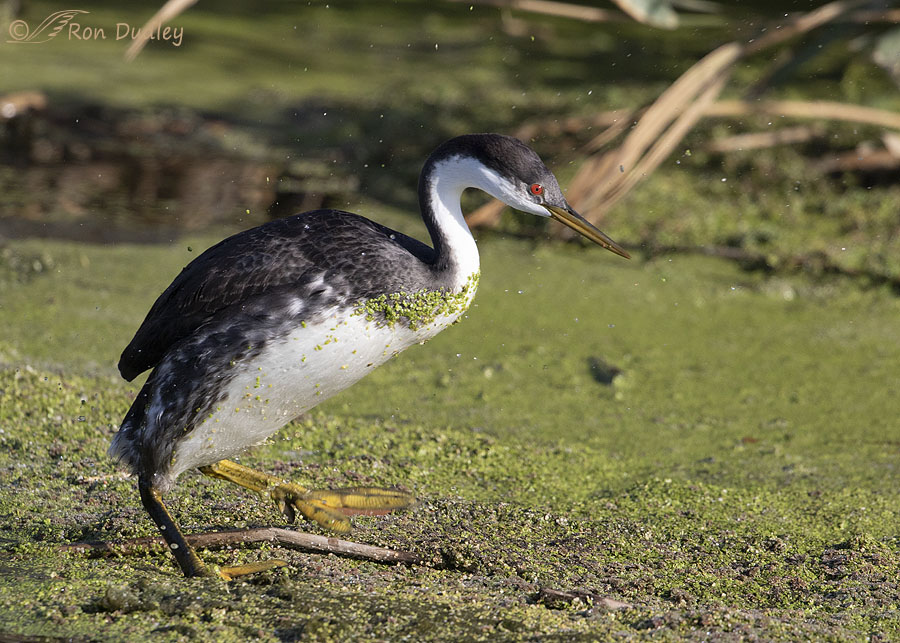
He could barely stand as he tried to walk.
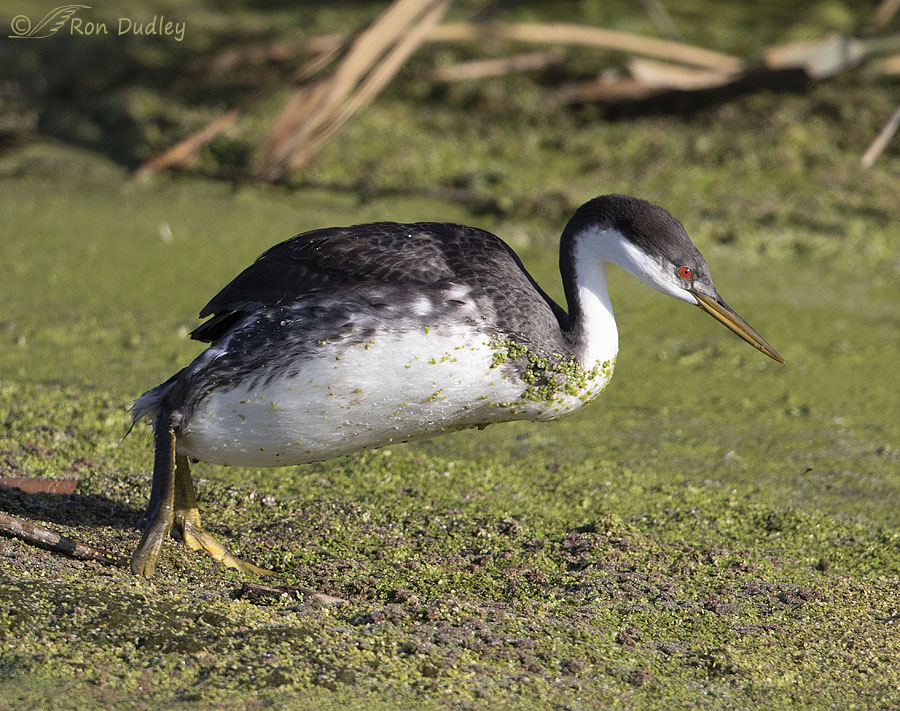
His body got too far in front of his feet so he had to…
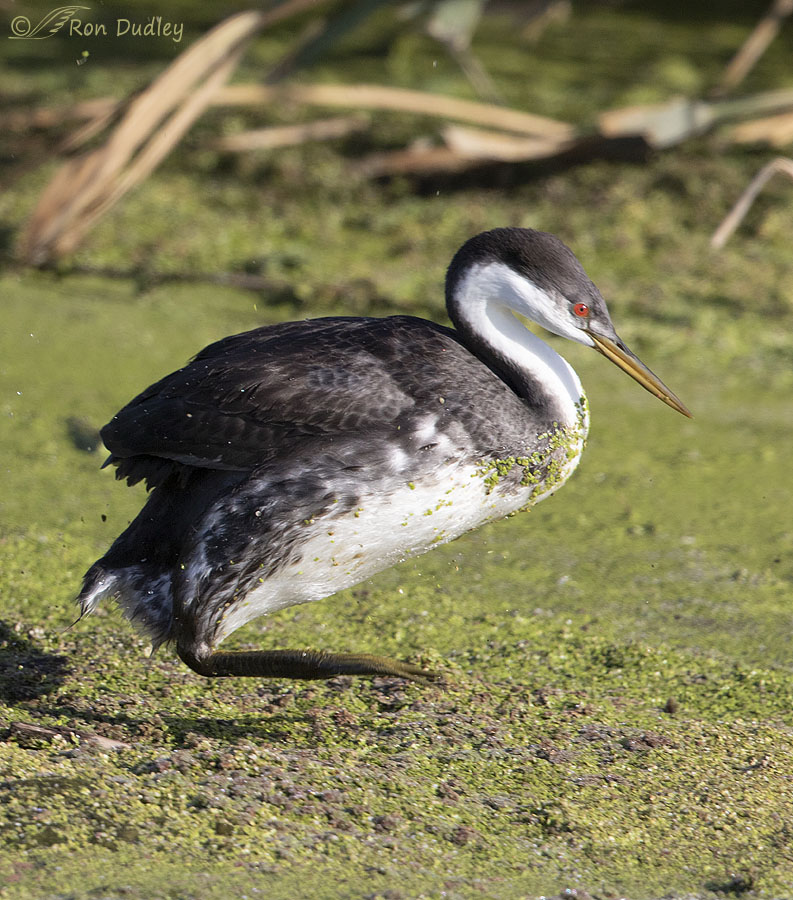
hop forward in an attempt to get them beneath him again but…
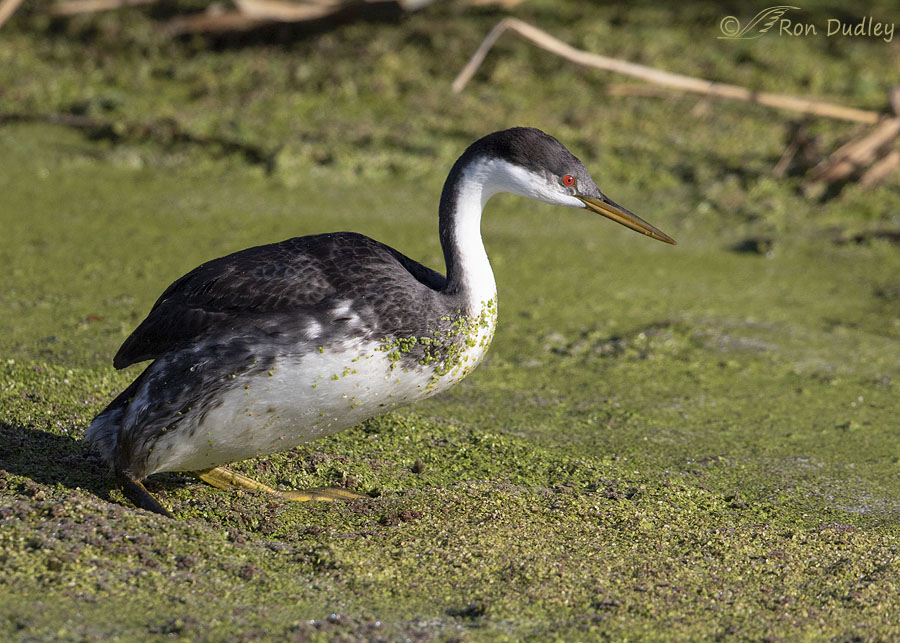
it didn’t work very well.
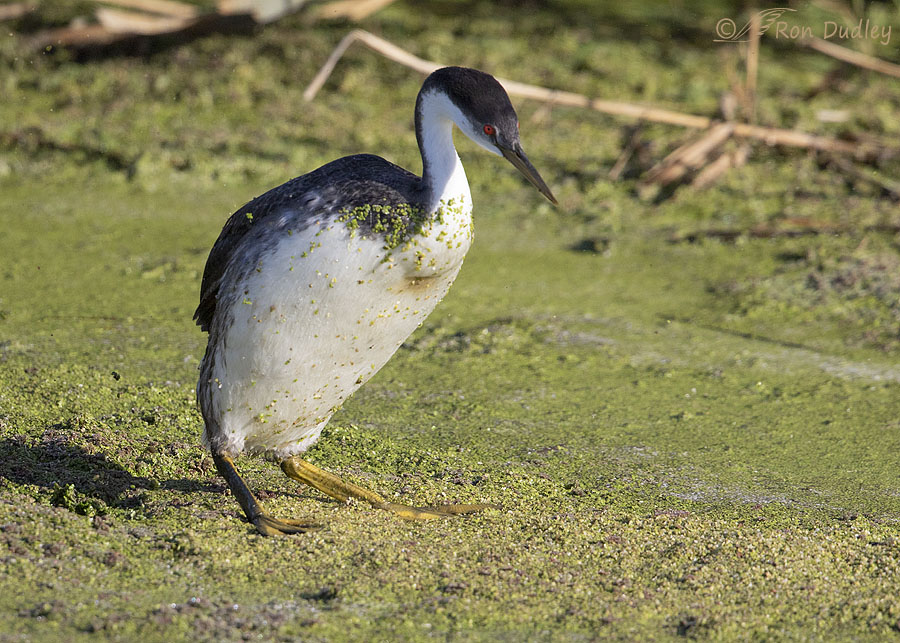
So for a brief moment he tried to stand without walking but only with limited success.
It didn’t take him long to decide that all this was a bad idea so he…
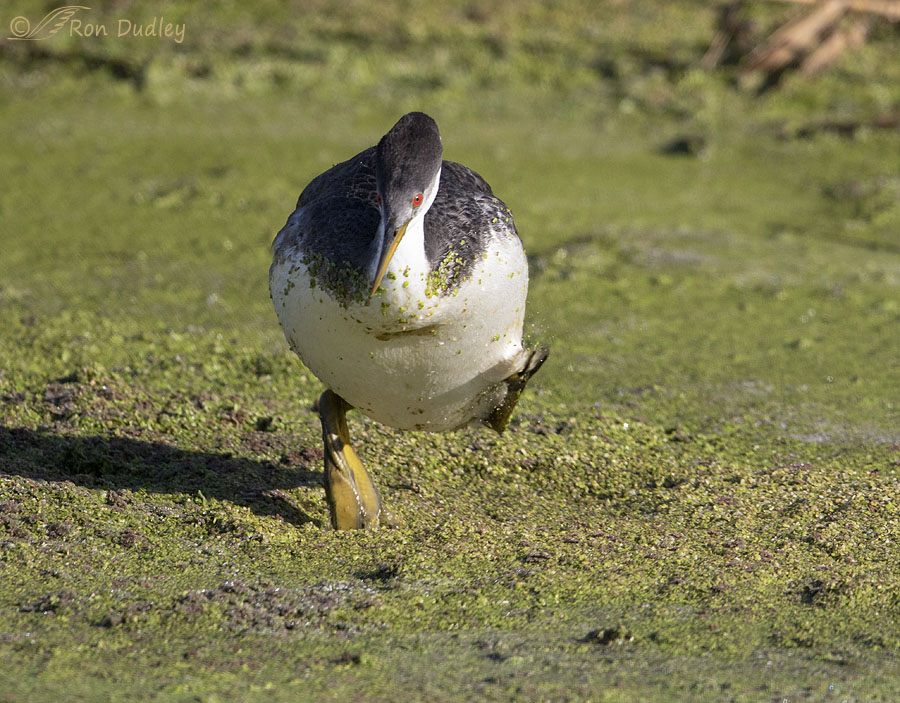
turned tail and began to skedaddle back to the security of the water.
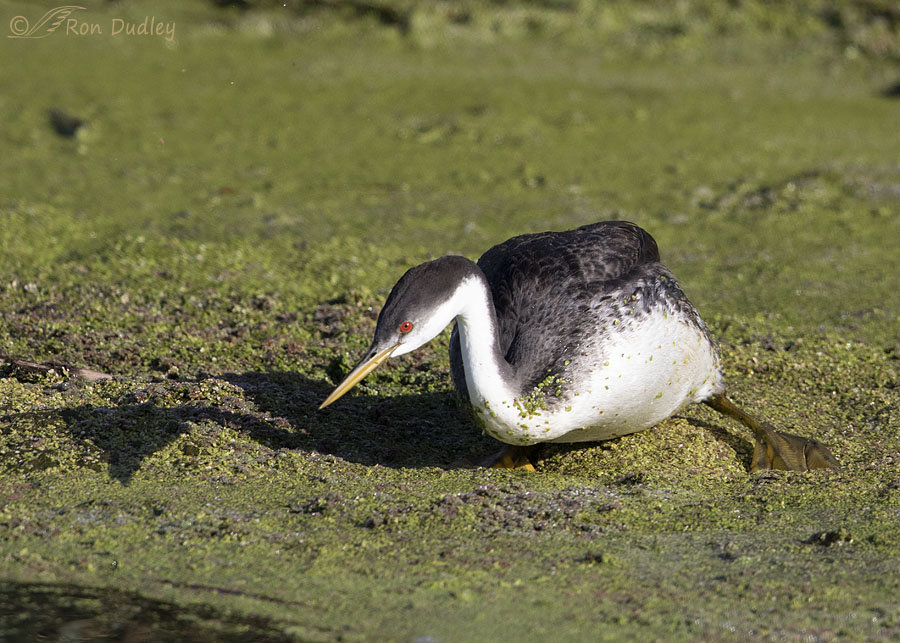
But making the transition from fairly solid ground beneath the duckweed to the water wasn’t easy. He plopped down on the shoreline…
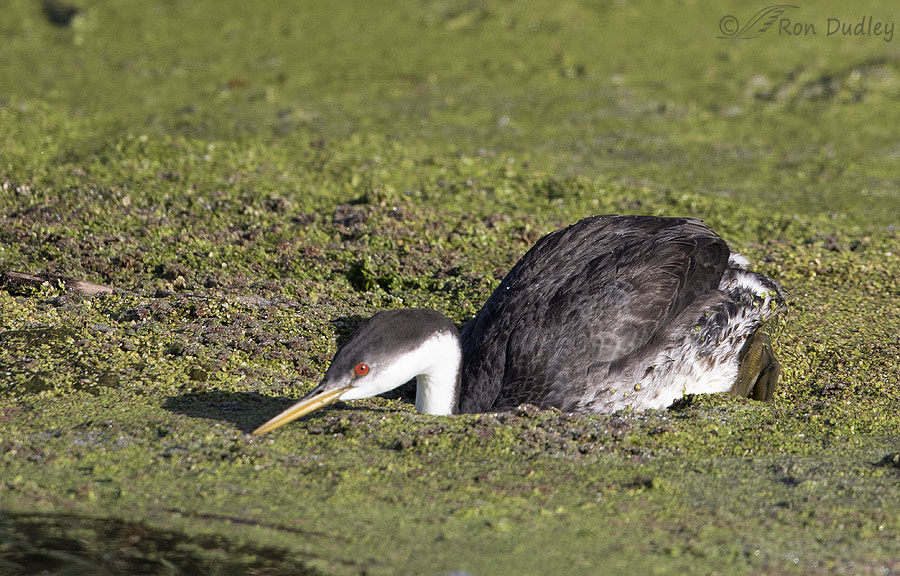
and appeared to try to push himself forward into the water (his feet are at or very near the shoreline beneath the duckweed) but apparently it was still too shallow and his body was dragging on the bottom so he…
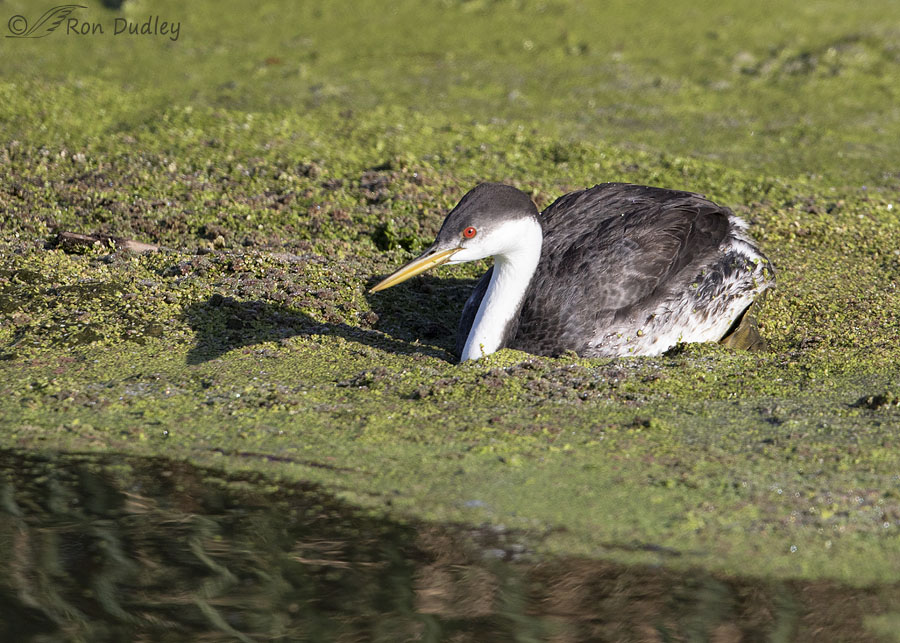
just sat there for a moment and thought about what he would do next. Eventually he cheated and…
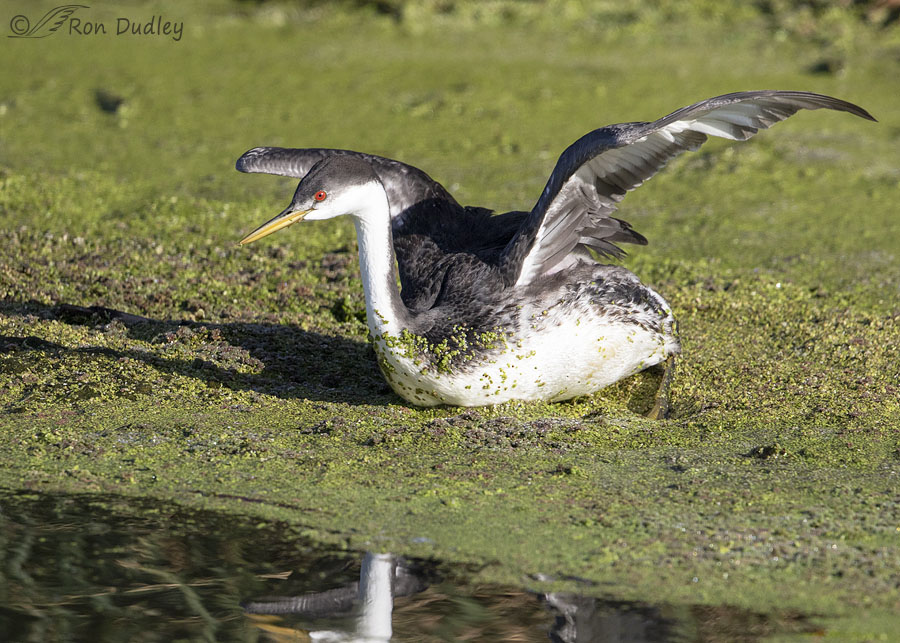
used his wings.
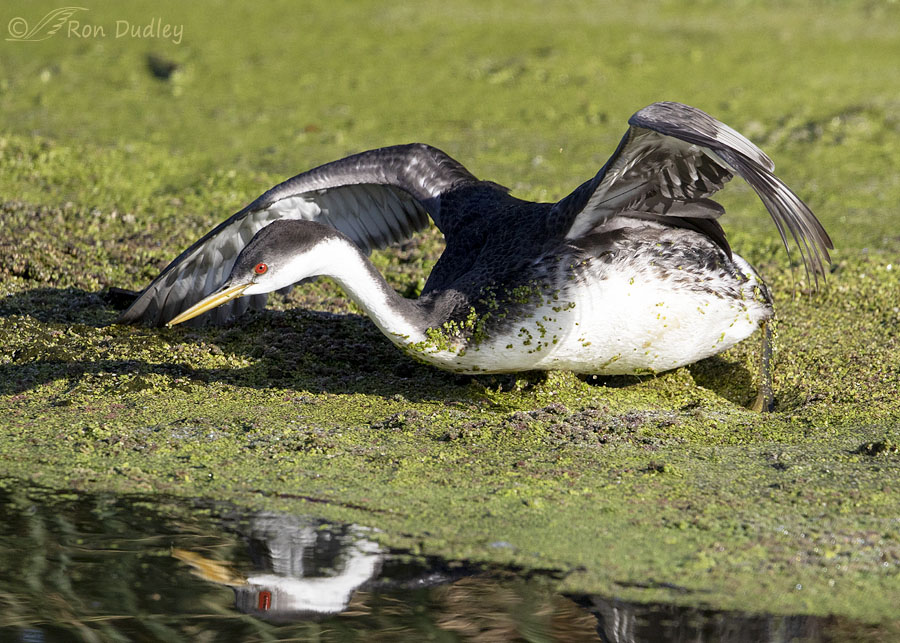
But even then it wasn’t easy and he had to…
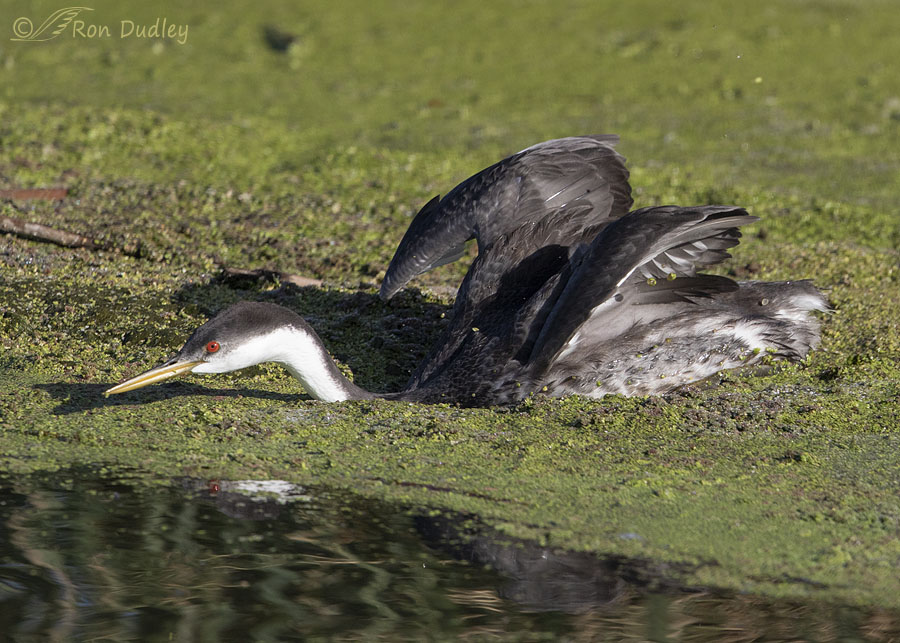
struggle to get into water deep enough so that…
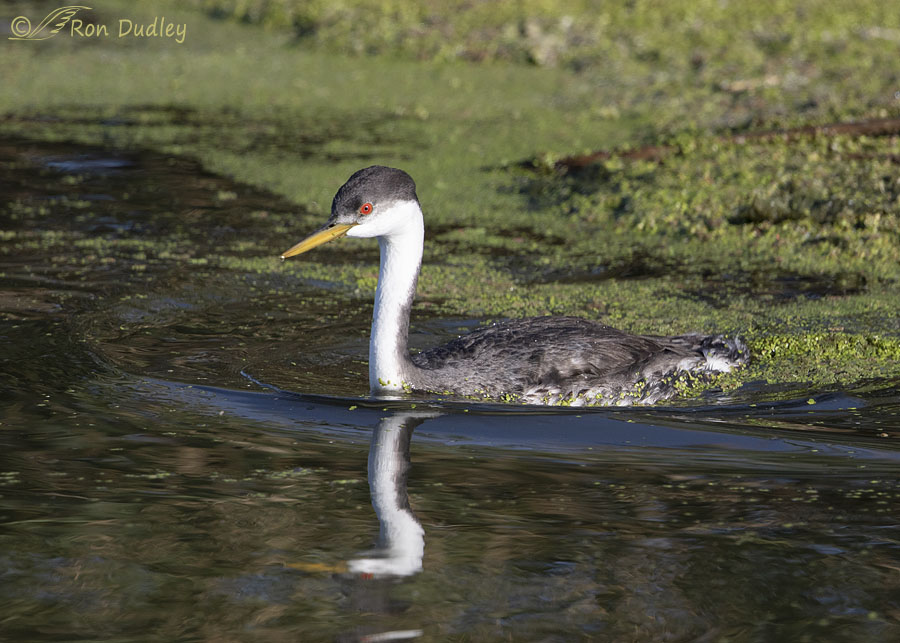
he could finally swim away and feel safe and secure again. He looks pretty pleased with himself doesn’t he.
Poor bird. He must have felt like a stranded whale while he was on the shore.
And I have to wonder what his original intention was that appealed to him so much that he even made the attempt. I’ll bet he didn’t try that again anytime soon.
Ron
Note: By now subscribers to my blog already know that last night I had another brain fart and published this post prematurely when it was far from complete. It’s just too damned easy to click on the “Publish” button instead of the “Save Draft” button when I’m composing a post. So I had to disable the post which meant that the link in the email subscribers received didn’t work.
Apologies. This is becoming an embarrassing habit…


Maybe there’s a lesson for us when we try to be something that we are not. Enjoyed the series and give credit to this grebe for trying. Ah well, it will be good practice for mating displays in the spring when they “stand” in the water.
“Maybe there’s a lesson for us when we try to be something that we are not.”
Excellent point, Jane – especially when applied to humans.
That head-on shot just makes me laugh.
This is such a great post. Had no idea how walking was so brutal for them.
He does look determined in that shot doesn’t he, Dave.
Ron,
Fascinating. Thanks.
Stephen
Thanks, Stephen.
At least you have a brain to fart with. Some mornings I am not sure that the same applies here.
Yet another fascinating series. Things I knew nothing about, illustrated for slow learners like myself. Thank you.
“At least you have a brain to fart with”
I’m not so sure I do at the moment, EC. I’ve been up since 1:55 AM so I’m basically functionless. I intend to take a long nap very soon…
good luck. there is an excellent reason why so many cultures use sleep deprivation as torture. It is. Nap well.
Thanks. It’s an old trick of mine to be dead on my feet from lack of sleep and still not be able to sleep when I try to nap.
Ooooh, I HATE that “too tired to sleep” feeling! 🙁
A Western Grebe trundling in the duckweed. How is it that I’m highly amused by such things?
I don’t know if it’s the lighting, but in that first shot the Western Grebe looks especially fluffy. It’s as if he were warming all of his feathers (and foot?) in the sun.
Amy, it’s common behavior for Western Grebes to stick their foot out behind them like that in order to dry it before they tuck it under their wing for warmth. But in this case it was simply a wing and leg stretch.
I think that bird looks “especially fluffy” because it’s a youngster.
Wow, always learn something from your posts. Thanks for sharing.
Good. Thanks, Elmer.
Lobed toes and “skedaddle” (such a great word, isn’t it) in the same post! Poor fella, though. I feel a little guilty about the level of birdy Schadenfreude I’m having. Glad he was able to get back to safety. The head on shot is definitely wall-worthy if for no other reason than comedic effect.
Don’t worry about “premature publication” (sorry – couldn’t resist). Your blog posts are definitely worth waiting for!
There’s something about those old fashioned descriptive terms isn’t there, Marty. I used the word “umpteen” with an older friend on Facebook recently and he really appreciated being reminded of it. As a kid my mother used to say to me “I’ve told you umpteen times not to do that”. ).
I actually came very close to using “premature publication” in my text but then thought some readers might not appreciate my attempt at humor. Now I wish I’d used it…
It’s safer this way — they can be mad at me, not you. 😉 (Actually, I had toyed with “premature E-publication” because it is an electronic posting. 😉 )
If there’s a way to be tactless, uncouth or have class-with-a-capital-K, I’ll find it!
Fascinating and informative series, thank you kindly. I frequently ponder the differing anatomies of bird genera/species, and how long/short a time in which the adaptations evolved, compared to other creatures. The placement of the insertion point of the leg on this grebe, for example, compared to the insertion point for murres, pelicans, loons. .
Fun things to ponder, Martha. I do the same.
This is fascinating. I hadn’t realized they might try to walk on purpose. Like many wildlife rehabilitators, I have had grebes (and loons) come in because they were flying during foggy weather and mistook wet pavement for water; landed; and then couldn’t get going again. Usually besides some minor abrasions, they are fine and we just check them over and taken them to a nearby open stretch of water (they need a fairly long, clear stretch in order to get airborne. Even with abrasions, we let them go right away as it’s never a good idea to keep them in human care for long: they can develop keel sores, as well as lose their water-proofing fairly quickly if not kept in water). I was visiting a friend in Wisconsin early one spring when there was a loon ‘fall out’ – we spent several days picking up loons from fields and roadside ditches, even a small pond too small for them to take off from. The upright posture you have documented here is amazing – I watched a defensive loon leap at my friend’s face from the ground. A bit scary given their sharp beaks! We always wear protective eye gear when working with these birds. Thanks, Ron!
Louise, nice to know you learned something from me rather than the other way around like it usually is! 🙂
I hadn’t thought about the possibility (likelihood) that they’d develop keel sores in captivity. Makes sense…
A few years ago we had many thousands of migrating Eared Grebes become stranded west of us in Tooele County. Caring folks saved a lot of them but many didn’t make it.
Beautiful series of photos Ron, and what a great story. Poor guy gave it his all, but nature just did not outfit him for walking. Those last few photos are especially good. The lighting is perfect for enhancing the colors and catch-eye and the photos are super sharp. Excellent work. And yes, got the post last night and did not even bother to open it knowing exactly what it was.:)
You’re right, Everett – he wasn’t equipped for the task at hand.
I suspect you’re not the only one who knew what I’d done as soon as that email appeared in their inbox at the wrong time of day.
Geat series! I’ve seen western grebes struggle to get into their nests, but never get out and walk around like this. The pictures of “his” walking almost upright really surprised me. The struggle to get into the water is more like what I’d have expected. Your being out there so often allows you to document things most of us never see, and your photo skills make them very easy to see and understand. i love the photo of the bird’s coming straight at you.
I appreciate the kind words, Nancy. Thanks.
NEAT! What a wonderful series – cheap entertainment for us tho I’m sure the Grebe wasn’t at all amused! :O Their feet are SO different along with where the legs are set. Laughed (sorry) when I saw the post last evening 🙂 Easy enough to do when one is concentrating or on auto pilot……
Ha, I can laugh about it today, Judy – but I sure as hell wasn’t laughing last night! I use the “Save Draft” button often when I’m composing my posts and the longer the post the more often I use it. Which means for this very long post I used it many, many times. An accident waiting to happen, at least for me…
Wonderful series. I’ve seen one Pied-billed grebe and one Eared Grebe attempt this. Neither got as far as your grebe and this is the first time I’ve seen a series of photos of this. Even getting up on their floating nests is sometimes a bit of a struggle. You have to wonder why an attempt to reach land was even made when it is so nearly impossible. “Because it’s there” work of human mountain climbers, maybe a similar thought occurred to this grebe. Thanks for sharing these.
Dan, I’ve seen it about a half-dozen times in Pied-billed but never in Eared Grebes. But then I spend much more time up close with the former. BTW, had a nice visit with Kelli Frame a couple of days ago and you were part of our conversation… 🙂
Wow! Thank you for showing this! Now I’m understanding how difficult it must be for them to nest, to get to a secure place to lay eggs and incubate them. I’m amazed that their evolutionary track has been and is successful with their leg placement being both such an advantage and disadvantage.
I’m amazed by the same thing you mention, Mikal.
Thank You, Thank You, Thank You !! I learn something from you every day. The position of these Grebe’s legs is interesting as compared to ducks such as a a Mallard which I am way more familiar with.
Thanks very much, Gary.
Great series, Ron. Thank you. I generally learn here and am grateful for your dedication to this project.
I appreciate that, Mark. Thanks.
Seems they are better at walking on water than on land. I’ve seen them doing their mating ritual where they skitter across the water while upright. Yes, that leg placement makes for interesting behavior.
You’re right, Justine. The behavior you describe is called “rushing”. I’ve photographed it several times.
Fascinating “footage”, Ron. I was chuckling through the whole post. “I think I’ll evolve into a land animal today. Wait, that takes thousand of years.”
Lyle, I was laughing when I had him in my viewfinder, to the point that I’m surprised that I was able to keep him in frame for this many shots.
Lyle – It’s like a live-action version of a Gary Larson cartoon, “Great Moments in Evolution”
🙂
Thank you for this very interesting insight into the life of grebes. I’ve never seen one even attempt to walk.
Thanks, David. It’s a rare sight to see with any of the grebe species but it does happen occasionally.
What a great series, Ron. I’d not thought about it, but it’s true; they stick to the water whenever they can, and I’ve never seen one on land. Now I know why! As for that premature posting, you’re certainly not alone. I’ve done it myself, and there isn’t a week passes by that I don’t get a ‘whoopsie’ in my mailbox from other bloggers.
I’m delighted to know that I’m not the only one, Shoreacres. I wish WordPress would move those two buttons further away from each other. Either that or make publishing a two step process. Ideally they’d do both.
Love this compilation! You’re right, don’t see these out of the water too much. Thank you for your blog – I so enjoy it every day!!
Thanks, Sibylle. I see Pied-billed Grebes out of the water slightly more often than Western’s or Clark’s but even with those little grebes it’s quite rare.